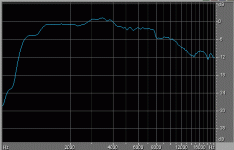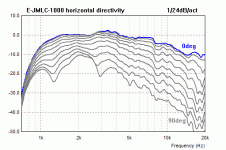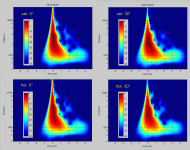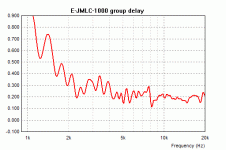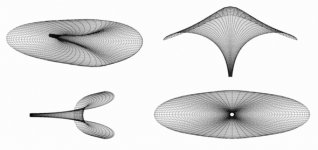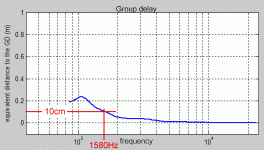How Not To Do a Horn and Driver Comparison- the ETF 2010 Story
How Not To Do a Horn and Driver Comparison- the ETF 2010 Story
I thought I would post the link to this critique of JMMLC's testing which has been discussed elsewhere.
It's of interest only as I don't believe JMMLC needs to futher justify his testing or his comments.
regards
tim
How Not To Do a Horn and Driver Comparison- the ETF 2010 Story
I thought I would post the link to this critique of JMMLC's testing which has been discussed elsewhere.
It's of interest only as I don't believe JMMLC needs to futher justify his testing or his comments.
regards
tim
I personally don't regard Le Cleac'h flare horns as "beamy". Conical horns don't necessarily produce a big wide sound stage either. Anyone using a horn system in the modern context is probably looking for the intimate sound described by Le Cleac'h as being a European preference.
I think Weiss is taking the whole shoot-out thing a little too seriously.
John
I think Weiss is taking the whole shoot-out thing a little too seriously.
John
How Not To Do a Horn and Driver Comparison- the ETF 2010 Story
I thought I would post the link to this critique of JMMLC's testing which has been discussed elsewhere.
It's of interest only as I don't believe JMMLC needs to futher justify his testing or his comments.
regards
tim
It's a horrible critique, with so many things wrong both on that forum and his statements in the AA forum... Kind'a makes me feel sorry for the author.
AA thread?
What is the title of the thread at AA? I did a quick search bit couldn't find it.
It's a horrible critique, with so many things wrong both on that forum and his statements in the AA forum... Kind'a makes me feel sorry for the author.
What is the title of the thread at AA? I did a quick search bit couldn't find it.
Hello,
Give a look to:
High Efficiency Speaker Asylum - 16 horns measurements - Jmmlc - December 07, 2010 at 01:50:12
and following messages
Best regards from Paris, France
Jean-Michel Le Cléac'h
What is the title of the thread at AA? I did a quick search bit couldn't find it.
Give a look to:
High Efficiency Speaker Asylum - 16 horns measurements - Jmmlc - December 07, 2010 at 01:50:12
and following messages
Best regards from Paris, France
Jean-Michel Le Cléac'h
Hello Jack,
There have been some comments on Internet about your published response curves (on and off axis) which are said to have been "too much smoothed".
In fact as anybody can verify it after importing and analysing the (attached in TXT format) impulse response you measured on axis for the blue prototype of the E-JMLC-1000,
the impulse response of that horn is,as ever with a Le Cléac'h horn, very smooth and therefore doesn't need any smoothing.
In a second attached file we can also see the screen copy of the FFT delivered by CoolEdit using the least smoothing (FFT length = 65536).
(Impulse response cut before the first reflection at 5ms).
Best regards from Paris, France
Jean-Michel Le Cléac'h
There have been some comments on Internet about your published response curves (on and off axis) which are said to have been "too much smoothed".
In fact as anybody can verify it after importing and analysing the (attached in TXT format) impulse response you measured on axis for the blue prototype of the E-JMLC-1000,
the impulse response of that horn is,as ever with a Le Cléac'h horn, very smooth and therefore doesn't need any smoothing.
In a second attached file we can also see the screen copy of the FFT delivered by CoolEdit using the least smoothing (FFT length = 65536).
(Impulse response cut before the first reflection at 5ms).
Best regards from Paris, France
Jean-Michel Le Cléac'h
E-JMLC-1000 - most beautiful small horn ever made? For sure can rival waveguides.
Attachments
Last edited:
Hello,
This E-JMLC horn possess an hyperbolical expansion of the area of the wavefronts (with T = 0.707 and Fc = 1000Hz).
I designed that kind of horn to provide a more constant horizontal directivity than the axisymetric Le Cléac'h horn while keeping a very efficient loading of the driver (allowing a better operation of the diaphragm and an efficient reduction of the distortion compared to waveguides).... That's why you can see a kind of beak at mouth.
I was puzzled when I saw that, few times after I designed this E-JMLC horn, the horn of studio monitor from SONY used such a feature, see:
http://www.audioheritage.org/vbulletin/attachment.php?attachmentid=13498&stc=1&d=1141815765
Even if Jack Zagaja measurements show that the directivity is very constant inside a 60° angle until 15kHz, allowing a wider listening zone, I don't call myself that horn a "constant directivity horn". There something very special about that kind of horn : the horizontal profile varues a lot with the cut-off frequency. IMHO the better shape is obtained with a frequency (around 300Hz) and in that case I think the angle inside which the directivity should be more constant could be reach 90°.
See attached graph.
But in that case the horn is very large and it will be very difficult to unmold, that's why Jack Zagaja asked me to calculate a first model usibng Fc = 1000Hz.
Best regards from Paris, France
Jean-Michel Le Cléac'h
This E-JMLC horn possess an hyperbolical expansion of the area of the wavefronts (with T = 0.707 and Fc = 1000Hz).
I designed that kind of horn to provide a more constant horizontal directivity than the axisymetric Le Cléac'h horn while keeping a very efficient loading of the driver (allowing a better operation of the diaphragm and an efficient reduction of the distortion compared to waveguides).... That's why you can see a kind of beak at mouth.
I was puzzled when I saw that, few times after I designed this E-JMLC horn, the horn of studio monitor from SONY used such a feature, see:
http://www.audioheritage.org/vbulletin/attachment.php?attachmentid=13498&stc=1&d=1141815765
Even if Jack Zagaja measurements show that the directivity is very constant inside a 60° angle until 15kHz, allowing a wider listening zone, I don't call myself that horn a "constant directivity horn". There something very special about that kind of horn : the horizontal profile varues a lot with the cut-off frequency. IMHO the better shape is obtained with a frequency (around 300Hz) and in that case I think the angle inside which the directivity should be more constant could be reach 90°.
See attached graph.
But in that case the horn is very large and it will be very difficult to unmold, that's why Jack Zagaja asked me to calculate a first model usibng Fc = 1000Hz.
Best regards from Paris, France
Jean-Michel Le Cléac'h
Nice! And in 10 degree increments, thanks.
Question: This is called JMLC-1000 because it has its -6dB point at 1000Hz? One would normally cross it higher, yeah?
Attachments
Last edited:
Hello Pano,
You'll find here attached the group delay curve of the E-JML-1000Hz (calculated from the published 0° pulse response using my own Matlab routine).
As I used to say, I use for myself the horns above the frequency above which their group delay (expressed in equivalent distance travelled at the speed of sound) becomes smaller than 10 centimeters (4 inches).
So I recommand to use that horn above 1580Hz.
Best regards from Paris, France
Jean-Michel Le Cléac'h
You'll find here attached the group delay curve of the E-JML-1000Hz (calculated from the published 0° pulse response using my own Matlab routine).
As I used to say, I use for myself the horns above the frequency above which their group delay (expressed in equivalent distance travelled at the speed of sound) becomes smaller than 10 centimeters (4 inches).
So I recommand to use that horn above 1580Hz.
Best regards from Paris, France
Jean-Michel Le Cléac'h
Nice! And in 10 degree increments, thanks.
Question: This is called JMLC-1000 because it has its -6dB point at 1000Hz? One would normally cross it higher, yeah?
Attachments
Nice! And in 10 degree increments, thanks.
Question: This is called JMLC-1000 because it has its -6dB point at 1000Hz? One would normally cross it higher, yeah?
1000 stands for calculated cut-off. Usually crossed one octave higher (group delay).
Bah.. Group delay is still low at 1000 Hz.
When I look at I' think of a single component for the horn at around 6 kHz for the low-pass, with an appropriate summing filter for the mid-range targeting around 1.6 kHz.
Last edited:
Nice horn, Jean-Michel & Jack Zagaja; looks like an ideal choice for a wideband 1" driver.
I can see why you are recommending 1580 Hz or higher as a crossover point: not only does the group delay increase fairly sharply below that (although it remains lower than many other horns), but pattern control is starting to go away, and diaphragm excursion is also going up as well.
One of the truly remarkable differences between a T=0.707 JMMLC profile and say, a conical, is the difference over the first octave to octave-and-a-half of operation. With the JMMLC, resistive diaphragm loading is present almost down to cutoff, while a conical needs to go an octave to an octave-and-a-half above cutoff to enter the resistive-load region. That has implications for IM distortion in a frequency range where the ear is most sensitive to distortion (which largely follows the Fletcher-Munson curves).
Some contributors might feel that pattern control is more important than IM distortion in the 1~5 kHz region; to me, that's a subjective call on the designer's part. One of the things I like about the patterns of the JMMLC horns is they are not constant-directivity; instead, they mimic the directivity of ideal direct-radiators, which I don't see as a bad thing at all. The interesting thing about this new horn is the directivity is similar to an ideal 6 x 9 (or smaller) elliptical speaker, but oriented vertically.
I can see why you are recommending 1580 Hz or higher as a crossover point: not only does the group delay increase fairly sharply below that (although it remains lower than many other horns), but pattern control is starting to go away, and diaphragm excursion is also going up as well.
One of the truly remarkable differences between a T=0.707 JMMLC profile and say, a conical, is the difference over the first octave to octave-and-a-half of operation. With the JMMLC, resistive diaphragm loading is present almost down to cutoff, while a conical needs to go an octave to an octave-and-a-half above cutoff to enter the resistive-load region. That has implications for IM distortion in a frequency range where the ear is most sensitive to distortion (which largely follows the Fletcher-Munson curves).
Some contributors might feel that pattern control is more important than IM distortion in the 1~5 kHz region; to me, that's a subjective call on the designer's part. One of the things I like about the patterns of the JMMLC horns is they are not constant-directivity; instead, they mimic the directivity of ideal direct-radiators, which I don't see as a bad thing at all. The interesting thing about this new horn is the directivity is similar to an ideal 6 x 9 (or smaller) elliptical speaker, but oriented vertically.
Last edited:
As I used to say, I use for myself the horns above the frequency above which their group delay (expressed in equivalent distance travelled at the speed of sound) becomes smaller than 10 centimeters (4 inches).
Best regards from Paris, France
Jean-Michel Le Cléac'h
What would this mean for the Iwata 300?
Frode
Hello Jean-Michel,
Could we suppose that the cutoff-frequency, in ballpark figures, can be twice the design-frequency?
Have just received my round 200Hz-horns for 2" driver and was, before this discussion, thinking of 350-400Hz cutoff. This without having done any calculations.
Could we suppose that the cutoff-frequency, in ballpark figures, can be twice the design-frequency?
Have just received my round 200Hz-horns for 2" driver and was, before this discussion, thinking of 350-400Hz cutoff. This without having done any calculations.
- Home
- Loudspeakers
- Multi-Way
- Jean Michel on LeCleac'h horns
